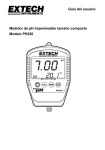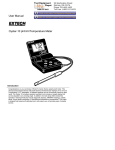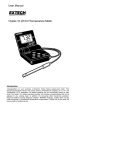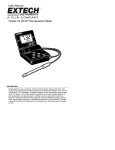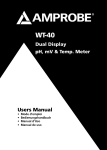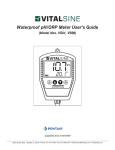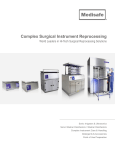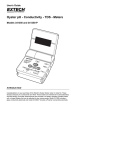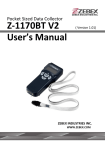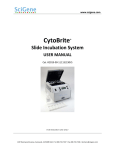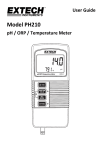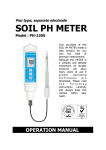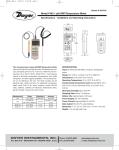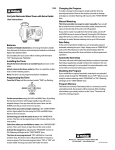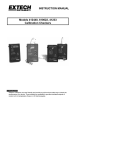Download Extech PH220-S User`s Manual
Transcript
User’s Guide Waterproof Palm pH Meter Model PH220 Introduction Congratulations on your purchase of the Extech PH220 waterproof pH/mV meter. This microprocessor-based device with tactile buttons is battery operated and ideal for field use. The PH220 simultaneously displays pH or ORP (mV) and temperature. The rubber holster which protects the meter has a magnetic backing for convenient mounting. Careful use of this meter will provide years of reliable service. Specifications mV (ORP) Temperature pH Range (Resolution) Accuracy ± 1999 mV DC (1 mV) ± 2mV o o o o 32.0 to 212.0 F (0.0 to 99.9 C) ± 0.5 F (0.3 C) 0.00 to 14.00pH (0.01pH) ± 0.02pH o o Temperature Compensation 32 to 212 F (0-100 C) Automatic (ATC) Power 9 volt battery Display Dual LCD display for simultaneous pH or mV and temperature readings Over-range or open indication Displays " ---- " for over-range or open input pH Calibration points 4.00, 7.00, 10.00 Auto Power OFF After 10 minutes Low Battery Indication The Dimensions / Weight 4.25 x 3.00 x 1.18" (108 x 75 x 30mm) / 0.3 lbs (135g) Accessories supplied with kit Sample buffers, and battery. Stick electrode for model PH220-S Electrode with 39” cable for model PH220-C icon displays no fill bars 2 Model PH220 Version 2.0 4/05 Meter Description 1. Battery Compartment (under holster) 2. Rubber Holster 3. LCD Display 4. Function buttons 5. Electrode input Display Description 3 Model PH220 Version 2.0 4/05 Calibration pH electrodes are like batteries; they run down with time and use. Because the sensitivity of a pH electrode degrades over time, it is very important to frequently calibrate the meter to the electrode. Calibration is performed using standard buffer solutions at room temperature (78°F, 25°C). Buffer solutions are solutions of a know pH that have the useful property of resisting changes in pH. These can be purchased already mixed or in capsule form and are usually available in three pH values, pH 4.00, pH 7.00 and pH 10.00. Calibration is always performed using the pH 7.00 buffer first, followed by a second calibration. Select pH 4 buffer for the second calibration if typical measurements will be less than pH7 or use a pH 10 buffer if typical measurements will be greater than ph 7. In order to obtain the most accurate results possible, a pH meter should be calibrated at least once a day. 2 Point Calibration Procedure 1. Turn the meter on. 2. Use the pH/mV button to select the pH mode. The unit of measure appears on the LCD. 3. Remove the electrode from its cap and rinse with distilled or deionized water 4. Place the electrode in fresh pH 7.00 buffer solution and stir. Allow 30 seconds for the electrode/ATC to reach thermal equilibrium with the buffer solution. 5. Press and hold the CAL key for three (3) seconds to enter the calibration mode. The ‘CAL’ display appears and then the pH value flashes on the LCD. 6. When the pH stops flashing, ‘SA’ (save), and then ‘END’ will appear in sequence. 7. Rinse the electrode with distilled or deionized water. 8. Place the electrode into the second buffer (pH 4.00 or pH 10.00) ands stir. Allow 30 seconds for the electrode/ATC to reach thermal equilibrium with the buffer solution. 9. Press and hold the CAL key for three (3) seconds to re-enter the calibration mode. The ‘CAL’ display appears and then the pH value flashes on the LCD. 10. When the pH stops flashing, ‘SA’ (save), the Slope percentage, and then ‘END’ will appear in sequence. 11. The meter is now calibrated and ready for use. Note: The Slope percentage is an indication of the health of the electrode. Since pH electrodes vary in performance from one to the next, this meter includes a feature that displays the electrode’s slope in %. If the slope % is below 75% the electrode should be replaced (a slope of 100% is ideal). 4 Model PH220 Version 2.0 4/05 PH Measurements 1. Connect the pH electrode to the meter. 2. Turn the meter on. 3. Use the pH/mV button to select the pH mode. The unit of measure appears on the LCD. 4. Rinse the electrode with distilled or deionized water. 5. Place the electrode in the solution. Allow 30 seconds for the electrode/ATC to reach thermal equilibrium with the buffer solution. 6. When the reading stabilizes, read the pH measurement on the main display. An out of range reading is indicated by three dashes ( - - - ). The dashes will also display if the electrode is not connected to the meter. 7. When the test is complete rinse the electrode with distilled or deionized water. Electrodes should always be rinsed before and between samples with distilled or deionized water to remove all traces of storage solution, process medium, or previous test solution.. Temperature Units o o o o To change the unit of measure for temperature ( C to F or F to C), press and hold the pH/mV button for 3 seconds. The LCD reflects the unit of measure. mV (ORP) Measurements 1. Connect the ORP electrode to the meter. 2. Rinse the ORP electrode 3. Turn the meter on. 4. Use the pH/mV button to select the mV mode. The display will reflect the unit of measure. 5. Place it into a sample solution. When the LCD stabilizes it will read the redox potential of the sample in millivolts (mV). 6. When the test is complete rinse the electrode with distilled or deionized water. 5 Model PH220 Version 2.0 4/05 Temperature Compensation Because the millivolt output of a pH electrode varies with temperature, the meter must compensate for the variations to obtain accurate measurements. The PH220 automatically compensates for solution temperatures that stray from room temperature using the thermometer that is built-in to the electrode. Temperature is displayed on the lower LCD line. Battery Replacement The 9V battery requires replacing when all three black bars inside the battery display icon switch off. Replace the battery per the following: 1. Remove the orange protective jacket holster that surrounds the meter by pulling it over the top of the meter (ensure that the electrode is disconnected). 2. Pull the battery compartment up from the top of the meter by the two indentations using two fingers. If necessary, pry the ends of the cover with a coin to release the watertight seal. 3. Install a fresh 9V battery. Battery polarity is indicated on the battery compartment cap. 4. To reinstall the battery compartment, align the notch in the cover with the grove in the meter and press. 5. Reinstall the protective holster. 6 Model PH220 Version 2.0 4/05 Electrode Maintenance and Troubleshooting Most pH measurement difficulties are caused by electrode problems. Careful handling and proper storage of the electrode will increase measurement accuracy. Electrodes should be rinsed to remove all traces of storage solution, process medium, or previous test solution. Electrode Storage The electrode should be stored in a soaker bottle or wetting cap filled with pH4 buffer. Never store an electrode in distilled or deionized water as this will cause migration of the fill solution from the electrode. Electrode Cleaning The type of electrode coating that occurs over time will determine the cleaning method. Soft coatings can be removed by vigorous stirring or by using a squirt bottle. Organic chemical coating (hard coatings) should be chemically removed. Only in extreme cases should the bulb be cleaned mechanically. Troubleshooting an Electrode Symptom Long response time or reading drift Cause Recommended Solution Clogged Junction Strong Alkaline measurement Deteriorated Gel layer Protein coating on electrode surface Oil, paint, dyes, suspended solids on sensor Organic solvents are coating sensor Dry Bulb Static Charge Dehydrated membrane Long term storage without wetting Wiping electrodes Same readings in different Cracked or broken bulb buffers and samples Erratic LCD display Samples have low ionic strength (lacks salt); e.g. distilled, de-ionized, boiled, lake water (high pressure) 7 Soak in 4.07 M Potassium Chloride (KCl) @ 60oC for 30 minutes. Soak in 0.1 M HCL overnight. Replace electrode. Soak in 1 gm Pepsin dissolved in 100ml of 0.1 m HCL for 30 mins. or as needed. Rinse electrode alternately with a materials solvent and a buffer 7.00. Organic mole fraction has to be less than 50% to assure reasonable readings. Limit time of measurement. Keep probe in the 7.0 buffer between readings. Read solution for dry bulb below: Soak electrode tip in wetting cap filled with 1ml 7.00 buffer for 24 to 48 hours Rinse electrode in 7.0 buffer and blot. Do no wipe electrode. Replace electrode. Use bulb guard. Avoid plunging electrode to bottom of container and spinning bars. Wetting cap will protect bulb between tests. For each 50 ml of sample add 1 drop (50uL) of SAT. KCl (No alteration in pH will occur by inert KCl). Model PH220 Version 2.0 4/05 Calibration and Repair Services EXTECH INSTRUMENTS CORPORATION offers complete repair and calibration services for all of the products we sell. For periodic calibration, NIST certification or repair on most Extech products, call customer service for details on services available. Extech recommends that calibration be performed on an annual basis to ensure calibration integrity. Warranty EXTECH INSTRUMENTS CORPORATION warrants this instrument to be free of defects in parts and workmanship for one year from date of shipment (a six month limited warranty applies to sensors and cables). If it should become necessary to return the instrument for service during or beyond the warranty period, contact the Customer Service Department at (781) 890-7440 ext. 210 for authorization or visit our website www.extech.com for contact information. A Return Authorization (RA) number must be issued before any product is returned to Extech. The sender is responsible for shipping charges, freight, insurance and proper packaging to prevent damage in transit. This warranty does not apply to defects resulting from action of the user such as misuse, improper wiring, operation outside of specification, improper maintenance or repair, or unauthorized modification. Extech specifically disclaims any implied warranties or merchantability or fitness for a specific purpose and will not be liable for any direct, indirect, incidental or consequential damages. Extech's total liability is limited to repair or replacement of the product. The warranty set forth above is inclusive and no other warranty, whether written or oral, is expressed or implied. Support line (781) 890-7440 Technical support: Extension 200; E-mail: [email protected] Repair & Returns: Extension 210; E-mail: [email protected] Product specifications subject to change without notice For the latest version of this User’s Guide, Software updates, and other up-to-the-minute product information, visit our website: www.extech.com Extech Instruments Corporation, 285 Bear Hill Rd., Waltham, MA 02451 Copyright © 2005 Extech Instruments Corporation All rights reserved including the right of reproduction in whole or in part in any form. 8 Model PH220 Version 2.0 4/05








